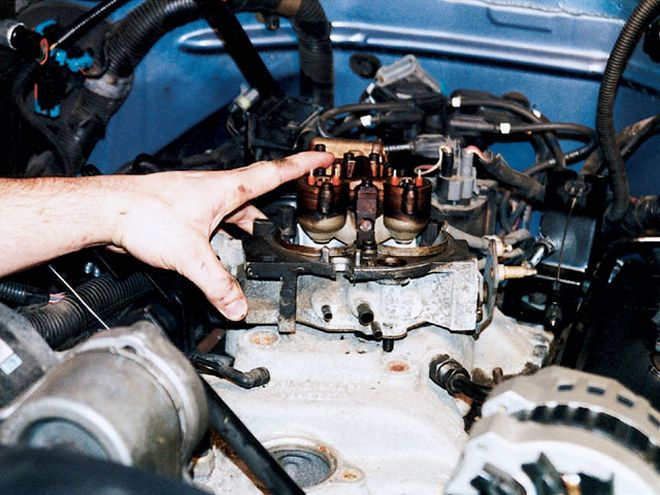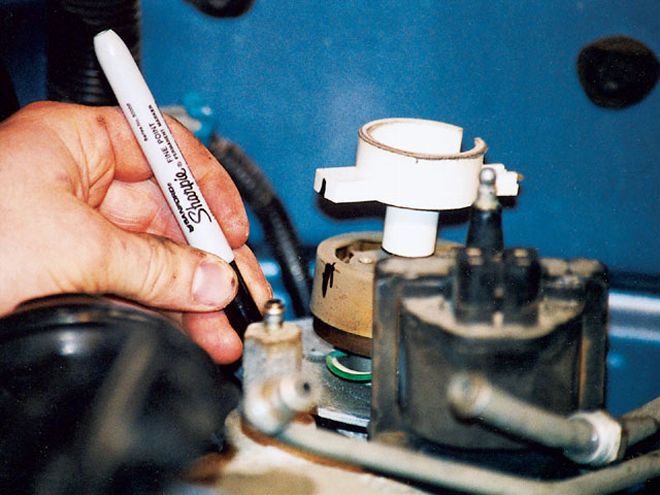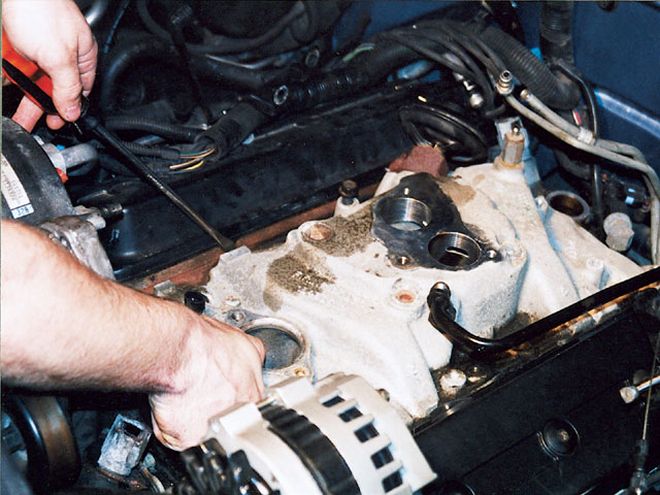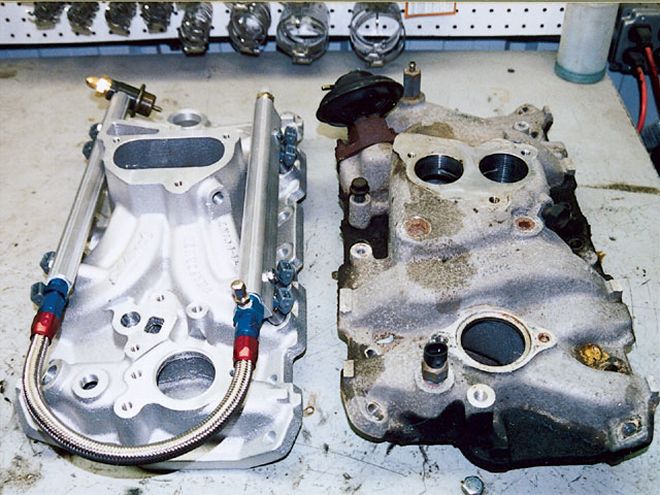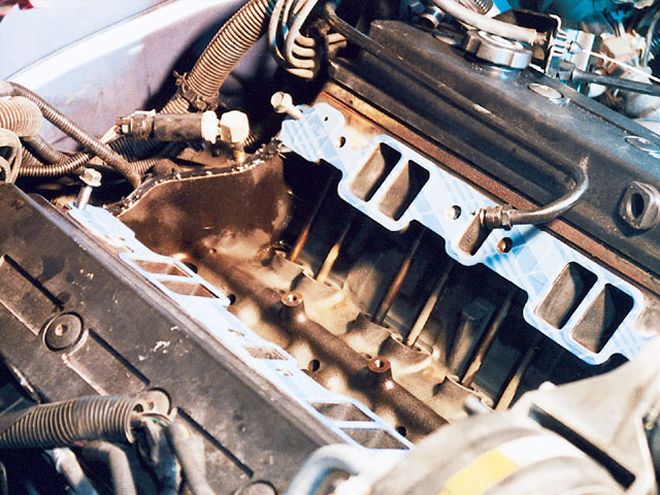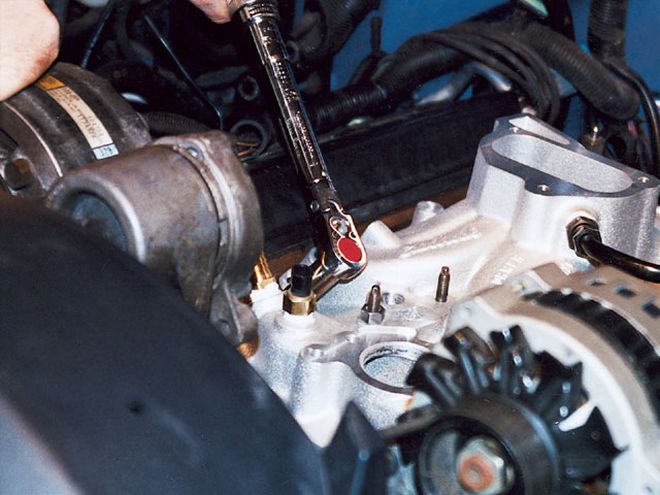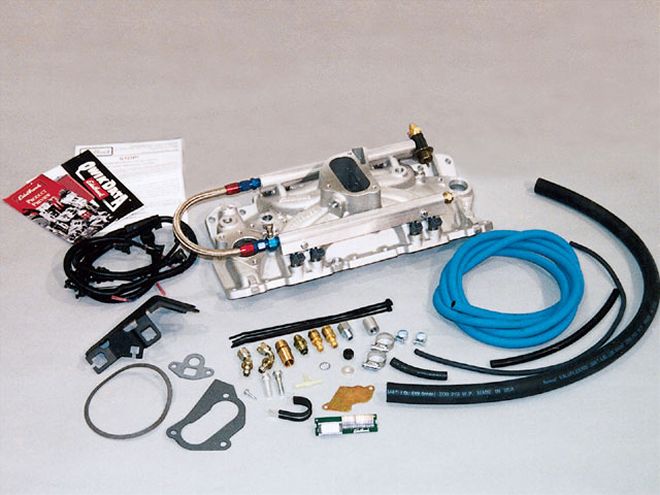
| Here's the out-of-the-box layout of the Edelbrock EFI kit for our '95 Tahoe. It includes the manifold, hoses, fittings, and wires necessary to complete the swap. Making the job simpler is the preassembled manifold, which comes with eight pico-style (short) fuel injectors, CNC-machined aluminum fuel rails, fuel crossover line, and fuel pressure regulator already installed. The only items missing (in our opinion) are the manifold gaskets and a tube of RTV sealant. By the way, the kit is emissions-legal and carries a CARB-exempt number.
As automotive technology has evolved, so has the performance world. And though carb and intake manifold swaps haven't disappeared altogether, the proliferation of fuel injection has certainly made them more rare.
We were reminded of the simpler days of induction when we got a look at Edelbrock's Performer EFI multipoint port fuel injection system. Of course, the Performer name is an old one in the world of intake manifolds, and the appearance of the EFI system's manifold looks like a high-rise single-plane intake for a two-barrel carb.
Edelbrock's system is designed to accept the throttle body of GM TBI-equipped engines (there are different systems for '88-'92 and '93-'95 engines, as well as big-block 7.4L engines), but replaces the two stock fuel injectors with eight port-mounted pico-style injectors. The stock TBI setup uses the two injectors in the air valve and sprays downward toward the throttle blades.
Like other OE port injection systems, Edelbrock's CARB-approved multipoint system uses a single injector for each intake port, spraying fuel more directly into the cylinder head. Edelbrock's claims of superior performance, driveability, and fuel economy compared with a throttle-body design are the very reasons most auto manufacturers have embraced port fuel injection. In fact, the Vortec line of GM truck small-blocks that debuted in 1996 featured port fuel injection, as do today's LS1-based engines.
Unfortunately, the Chevy Tahoe that goes under the knife in this story was screwed together just a year too early. It's a '95 model, equipped with the LO5 350-cid small-block. That means TBI and just 205 hp from the factory. Owned by SLP Performance Parts' chief engineer, Brian Reese, the 100,000-mile truck had already been perked up with the addition of a custom cold-air intake, headers, after-cat exhaust, and 180-degree thermostat - all taken off the company's shelves (it, uh, was a research project).
A set of Comp Cams' 1.6-ratio roller rockers and a custom Hypertech power chip were added, too. With all those bolt-on goodies, the previously tepid Tahoe's rear-wheel output (measured on the Dynojet at New Jersey's Cartek Racing) jumped from 149.3 hp and 250.5 lb-ft of torque to 175.5 rear-wheel horses and 301.3 lb-ft - a significant 18.6 percent improvement.
For the sake of curiosity - not to mention, the nagging quest for more performance - Reese wanted to give the Edelbrock EFI kit a try. Figuring it was better to let someone ruin his own vehicle, rather than one of ours, we told Reese to go for it. And, what the heck, if the truck ran afterward, we'd cover the swap in the magazine.
As it turns out, we need not have worried. The Edelbrock EFI system was very complete and the installation was straightforward. That's not to say it wasn't complicated, though. There are a few tricks to the install and not every part needed for it is included with the kit.
Here are some of our notes since the project's completion. Keep them in mind if you're contemplating a similar swap:
The computer's PROM chip must be replaced. Doing so requires the buyer to fill out an information card with information found on the vehicle's RPO sticker and ECM computer. The card must be sent to Edelbrock, which sends the new chip. The round-trip service for our Tahoe took six days.
We were lucky: Our '95 truck did not require a new fuel pump. However, anything other than a '95 Tahoe requires an upgraded pump. On SUVs, that means dropping the tank. On pickups, you'll be removing the bed. Edelbrock offers the higher-capacity pump, but it's an extra-cost item for the project.
Two items not included with the kit are intake manifold gaskets and RTV sealant. Minor items, yes, but you'll really miss them once the old parts are removed and you don't have a ride to the auto parts store. Stock up before you begin the project.
There's a gasket included with the block-off plate for the fuel inlet/outlet positions on the throttle body. In our opinion, the plate seemed a little too thin and flexible, and we could see daylight around the gasket after it was installed. We decided to remove the gasket and use a healthy dollop of RTV instead.
The kit's fuel line push-on connectors were very tough to push together. How tough? We needed a vice and lube to squeeze them together.
In all, it took about eight hours to complete the installation. And while our hands were dirty (well, while Reese's hands were dirty), we decided to replace the engine-driven fan with an electric unit from Flex-a-lite. With the previously installed 180-degree thermostat, the fan not only improves cooling, but its adjustable thermostat allowed us to dial in the truck's cooling needs.
When all the work was completed, it was back to Cartek Racing for some follow-up runs on the Dynojet. With simply the injection swap and new fan, the Tahoe's peak output at the rear wheels jumped from 175.5 to 197.9 hp. Torque leaped from 301.3 lb-ft to 313.4 lb-ft at the tires.
More telling, however, was the new injection system's performance across the powerbands. Although peak horsepower jumped more than 22 hp, it occurred at just 2,700 rpm. As the tach edged higher, the difference between the stock TBI setup and Edelbrock's EFI system was more pronounced. By 3,700 rpm, the new setup was producing 194 horses, a 25.2hp gain over the TBI's 168.8 ponies at the same rpm.
The same goes for torque. By 3,100 rpm, the Edelbrock-fed 350 made 28-35 lb-ft of torque more than the TBI setup through 4,100 rpm. This is especially helpful on the street, as the torque curve starts to head south on the motor by 3,100 rpm. While it doesn't reverse this trait, the Edelbrock system nonetheless props up the engine's pulling power to the redline. (We suspect some of the horsepower and torque gains came from the removal of the engine-driven fan, too, which reduced some parasitic drag on the engine.)
Edelbrock's EFI system retails for about $1,000. In our experience with the Tahoe, we think it offers good bang for the buck - not only in outright performance, but overall driveability as well. Yes, the install is more complicated than the old carb and intake swap. But, hey, there's no need to tinker with a inicky carburetor afterward.
For 25 horses and 35 lb-ft at the tires, we'll gladly put up with a little complication.
 | Here's the out-of-the-box layout of the Edelbrock EFI kit for our '95 Tahoe. It includes the manifold, hoses, fittings, and wires necessary to complete the swap. Making the job simpler is the preassembled manifold, which comes with eight pico-style (short) fuel injectors, CNC-machined aluminum fuel rails, fuel crossover line, and fuel pressure regulator already installed. The only items missing (in our opinion) are the manifold gaskets and a tube of RTV sealant. By the way, the kit is emissions-legal and carries a CARB-exempt number.
As automotive technology has evolved, so has the performance world. And though carb and intake manifold swaps haven't disappeared altogether, the proliferation of fuel injection has certainly made them more rare.
We were reminded of the simpler days of induction when we got a look at Edelbrock's Performer EFI multipoint port fuel injection system. Of course, the Performer name is an old one in the world of intake manifolds, and the appearance of the EFI system's manifold looks like a high-rise single-plane intake for a two-barrel carb.
Edelbrock's system is designed to accept the throttle body of GM TBI-equipped engines (there are different systems for '88-'92 and '93-'95 engines, as well as big-block 7.4L engines), but replaces the two stock fuel injectors with eight port-mounted pico-style injectors. The stock TBI setup uses the two injectors in the air valve and sprays downward toward the throttle blades.
Like other OE port injection systems, Edelbrock's CARB-approved multipoint system uses a single injector for each intake port, spraying fuel more directly into the cylinder head. Edelbrock's claims of superior performance, driveability, and fuel economy compared with a throttle-body design are the very reasons most auto manufacturers have embraced port fuel injection. In fact, the Vortec line of GM truck small-blocks that debuted in 1996 featured port fuel injection, as do today's LS1-based engines.
Unfortunately, the Chevy Tahoe that goes under the knife in this story was screwed together just a year too early. It's a '95 model, equipped with the LO5 350-cid small-block. That means TBI and just 205 hp from the factory. Owned by SLP Performance Parts' chief engineer, Brian Reese, the 100,000-mile truck had already been perked up with the addition of a custom cold-air intake, headers, after-cat exhaust, and 180-degree thermostat - all taken off the company's shelves (it, uh, was a research project).
A set of Comp Cams' 1.6-ratio roller rockers and a custom Hypertech power chip were added, too. With all those bolt-on goodies, the previously tepid Tahoe's rear-wheel output (measured on the Dynojet at New Jersey's Cartek Racing) jumped from 149.3 hp and 250.5 lb-ft of torque to 175.5 rear-wheel horses and 301.3 lb-ft - a significant 18.6 percent improvement.
For the sake of curiosity - not to mention, the nagging quest for more performance - Reese wanted to give the Edelbrock EFI kit a try. Figuring it was better to let someone ruin his own vehicle, rather than one of ours, we told Reese to go for it. And, what the heck, if the truck ran afterward, we'd cover the swap in the magazine.
As it turns out, we need not have worried. The Edelbrock EFI system was very complete and the installation was straightforward. That's not to say it wasn't complicated, though. There are a few tricks to the install and not every part needed for it is included with the kit.
Here are some of our notes since the project's completion. Keep them in mind if you're contemplating a similar swap:
The computer's PROM chip must be replaced. Doing so requires the buyer to fill out an information card with information found on the vehicle's RPO sticker and ECM computer. The card must be sent to Edelbrock, which sends the new chip. The round-trip service for our Tahoe took six days.
We were lucky: Our '95 truck did not require a new fuel pump. However, anything other than a '95 Tahoe requires an upgraded pump. On SUVs, that means dropping the tank. On pickups, you'll be removing the bed. Edelbrock offers the higher-capacity pump, but it's an extra-cost item for the project.
Two items not included with the kit are intake manifold gaskets and RTV sealant. Minor items, yes, but you'll really miss them once the old parts are removed and you don't have a ride to the auto parts store. Stock up before you begin the project.
There's a gasket included with the block-off plate for the fuel inlet/outlet positions on the throttle body. In our opinion, the plate seemed a little too thin and flexible, and we could see daylight around the gasket after it was installed. We decided to remove the gasket and use a healthy dollop of RTV instead.
The kit's fuel line push-on connectors were very tough to push together. How tough? We needed a vice and lube to squeeze them together.
In all, it took about eight hours to complete the installation. And while our hands were dirty (well, while Reese's hands were dirty), we decided to replace the engine-driven fan with an electric unit from Flex-a-lite. With the previously installed 180-degree thermostat, the fan not only improves cooling, but its adjustable thermostat allowed us to dial in the truck's cooling needs.
When all the work was completed, it was back to Cartek Racing for some follow-up runs on the Dynojet. With simply the injection swap and new fan, the Tahoe's peak output at the rear wheels jumped from 175.5 to 197.9 hp. Torque leaped from 301.3 lb-ft to 313.4 lb-ft at the tires.
More telling, however, was the new injection system's performance across the powerbands. Although peak horsepower jumped more than 22 hp, it occurred at just 2,700 rpm. As the tach edged higher, the difference between the stock TBI setup and Edelbrock's EFI system was more pronounced. By 3,700 rpm, the new setup was producing 194 horses, a 25.2hp gain over the TBI's 168.8 ponies at the same rpm.
The same goes for torque. By 3,100 rpm, the Edelbrock-fed 350 made 28-35 lb-ft of torque more than the TBI setup through 4,100 rpm. This is especially helpful on the street, as the torque curve starts to head south on the motor by 3,100 rpm. While it doesn't reverse this trait, the Edelbrock system nonetheless props up the engine's pulling power to the redline. (We suspect some of the horsepower and torque gains came from the removal of the engine-driven fan, too, which reduced some parasitic drag on the engine.)
Edelbrock's EFI system retails for about $1,000. In our experience with the Tahoe, we think it offers good bang for the buck - not only in outright performance, but overall driveability as well. Yes, the install is more complicated than the old carb and intake swap. But, hey, there's no need to tinker with a inicky carburetor afterward.
For 25 horses and 35 lb-ft at the tires, we'll gladly put up with a little complication.
| Here's the out-of-the-box layout of the Edelbrock EFI kit for our '95 Tahoe. It includes the manifold, hoses, fittings, and wires necessary to complete the swap. Making the job simpler is the preassembled manifold, which comes with eight pico-style (short) fuel injectors, CNC-machined aluminum fuel rails, fuel crossover line, and fuel pressure regulator already installed. The only items missing (in our opinion) are the manifold gaskets and a tube of RTV sealant. By the way, the kit is emissions-legal and carries a CARB-exempt number.
As automotive technology has evolved, so has the performance world. And though carb and intake manifold swaps haven't disappeared altogether, the proliferation of fuel injection has certainly made them more rare.
We were reminded of the simpler days of induction when we got a look at Edelbrock's Performer EFI multipoint port fuel injection system. Of course, the Performer name is an old one in the world of intake manifolds, and the appearance of the EFI system's manifold looks like a high-rise single-plane intake for a two-barrel carb.
Edelbrock's system is designed to accept the throttle body of GM TBI-equipped engines (there are different systems for '88-'92 and '93-'95 engines, as well as big-block 7.4L engines), but replaces the two stock fuel injectors with eight port-mounted pico-style injectors. The stock TBI setup uses the two injectors in the air valve and sprays downward toward the throttle blades.
Like other OE port injection systems, Edelbrock's CARB-approved multipoint system uses a single injector for each intake port, spraying fuel more directly into the cylinder head. Edelbrock's claims of superior performance, driveability, and fuel economy compared with a throttle-body design are the very reasons most auto manufacturers have embraced port fuel injection. In fact, the Vortec line of GM truck small-blocks that debuted in 1996 featured port fuel injection, as do today's LS1-based engines.
Unfortunately, the Chevy Tahoe that goes under the knife in this story was screwed together just a year too early. It's a '95 model, equipped with the LO5 350-cid small-block. That means TBI and just 205 hp from the factory. Owned by SLP Performance Parts' chief engineer, Brian Reese, the 100,000-mile truck had already been perked up with the addition of a custom cold-air intake, headers, after-cat exhaust, and 180-degree thermostat - all taken off the company's shelves (it, uh, was a research project).
A set of Comp Cams' 1.6-ratio roller rockers and a custom Hypertech power chip were added, too. With all those bolt-on goodies, the previously tepid Tahoe's rear-wheel output (measured on the Dynojet at New Jersey's Cartek Racing) jumped from 149.3 hp and 250.5 lb-ft of torque to 175.5 rear-wheel horses and 301.3 lb-ft - a significant 18.6 percent improvement.
For the sake of curiosity - not to mention, the nagging quest for more performance - Reese wanted to give the Edelbrock EFI kit a try. Figuring it was better to let someone ruin his own vehicle, rather than one of ours, we told Reese to go for it. And, what the heck, if the truck ran afterward, we'd cover the swap in the magazine.
As it turns out, we need not have worried. The Edelbrock EFI system was very complete and the installation was straightforward. That's not to say it wasn't complicated, though. There are a few tricks to the install and not every part needed for it is included with the kit.
Here are some of our notes since the project's completion. Keep them in mind if you're contemplating a similar swap:
The computer's PROM chip must be replaced. Doing so requires the buyer to fill out an information card with information found on the vehicle's RPO sticker and ECM computer. The card must be sent to Edelbrock, which sends the new chip. The round-trip service for our Tahoe took six days.
We were lucky: Our '95 truck did not require a new fuel pump. However, anything other than a '95 Tahoe requires an upgraded pump. On SUVs, that means dropping the tank. On pickups, you'll be removing the bed. Edelbrock offers the higher-capacity pump, but it's an extra-cost item for the project.
Two items not included with the kit are intake manifold gaskets and RTV sealant. Minor items, yes, but you'll really miss them once the old parts are removed and you don't have a ride to the auto parts store. Stock up before you begin the project.
There's a gasket included with the block-off plate for the fuel inlet/outlet positions on the throttle body. In our opinion, the plate seemed a little too thin and flexible, and we could see daylight around the gasket after it was installed. We decided to remove the gasket and use a healthy dollop of RTV instead.
The kit's fuel line push-on connectors were very tough to push together. How tough? We needed a vice and lube to squeeze them together.
In all, it took about eight hours to complete the installation. And while our hands were dirty (well, while Reese's hands were dirty), we decided to replace the engine-driven fan with an electric unit from Flex-a-lite. With the previously installed 180-degree thermostat, the fan not only improves cooling, but its adjustable thermostat allowed us to dial in the truck's cooling needs.
When all the work was completed, it was back to Cartek Racing for some follow-up runs on the Dynojet. With simply the injection swap and new fan, the Tahoe's peak output at the rear wheels jumped from 175.5 to 197.9 hp. Torque leaped from 301.3 lb-ft to 313.4 lb-ft at the tires.
More telling, however, was the new injection system's performance across the powerbands. Although peak horsepower jumped more than 22 hp, it occurred at just 2,700 rpm. As the tach edged higher, the difference between the stock TBI setup and Edelbrock's EFI system was more pronounced. By 3,700 rpm, the new setup was producing 194 horses, a 25.2hp gain over the TBI's 168.8 ponies at the same rpm.
The same goes for torque. By 3,100 rpm, the Edelbrock-fed 350 made 28-35 lb-ft of torque more than the TBI setup through 4,100 rpm. This is especially helpful on the street, as the torque curve starts to head south on the motor by 3,100 rpm. While it doesn't reverse this trait, the Edelbrock system nonetheless props up the engine's pulling power to the redline. (We suspect some of the horsepower and torque gains came from the removal of the engine-driven fan, too, which reduced some parasitic drag on the engine.)
Edelbrock's EFI system retails for about $1,000. In our experience with the Tahoe, we think it offers good bang for the buck - not only in outright performance, but overall driveability as well. Yes, the install is more complicated than the old carb and intake swap. But, hey, there's no need to tinker with a inicky carburetor afterward.
For 25 horses and 35 lb-ft at the tires, we'll gladly put up with a little complication.
